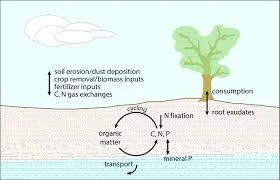Definition: An agricultural data management system is a tool that helps farmers collect, store, and analyze data related to their crops and fields. This data can include a variety of information.
Click the Translate button(see right) on this post to set your Own Language to understand more perfectly!!
Agricultural Data Management System
Welcome to the Agricultural Data Management System. Please input your data below:
Continue Definition:
An agricultural data management system is a tool that helps farmers collect, store, and analyze data related to their crops and fields. This data can include a variety of information, such as:
Crop yield: The amount of crops harvested from a particular field.
Weather data: Rainfall, temperature, humidity, and other weather conditions that can affect crop growth.
Soil test data: The chemical and physical properties of the soil, such as pH, nutrient levels, and organic matter content.
Soil management practices: The techniques used to manage the soil, such as tillage, fertilization, and irrigation.
By collecting and analyzing this data, farmers can gain valuable insights into their operations and make more informed decisions. For example, a farmer might use their data to:
Identify trends: They can see how crop yields have changed over time in response to different factors, such as weather conditions or soil management practices.
Identify problems: Data analysis can help identify potential problems, such as nutrient deficiencies in the soil or pests and diseases affecting the crops.
Improve decision-making: With a better understanding of the factors that affect crop yields, farmers can make more informed decisions about planting, fertilization, irrigation, and other management practices.
Finding conclusions from agricultural data:
Here's how you can find conclusions from the data you mentioned:
Correlations: You can analyze the data to see if there are any correlations between different factors. For example, you might find that there is a positive correlation between crop yield and rainfall, or a negative correlation between crop yield and soil salinity.
Statistical methods: More sophisticated statistical methods can be used to analyze the data and identify statistically significant relationships between variables.
Machine learning models: Machine learning models can be used to identify complex patterns in the data that might not be apparent through simpler analysis methods.
Calculating target values:
An agricultural data management system can be used to calculate target values, such as a desired crop yield for a particular field. Once a target yield is set, the farmer can use the data to identify factors that need to be adjusted to achieve that target. For example, if the target yield is higher than the historical average for the field, the farmer might need to adjust their fertilization or irrigation practices.
Example:
Let's say a farmer has been collecting data on crop yield, rainfall, and nitrogen content in their soil for several years. They can use an agricultural data management system to analyze this data and see if there is a correlation between these factors. If they find that there is a positive correlation between crop yield and nitrogen content, they can then set a target yield for the following year and use the data to calculate how much nitrogen fertilizer they need to apply to their fields to achieve that target yield.
Of course, this is a simplified example. In practice, agricultural data management systems use more sophisticated statistical methods and machine learning models to analyze complex relationships between factors and optimize crop yields.
How to EARN MONEY using the knowlede of Agriculture Data Management System?????
Yes, there are a few ways to earn money using an agricultural data management system (ADMS):
1. Selling anonymized data: There is a growing market for anonymized agricultural data. This data can be valuable to researchers, agricultural companies, and other organizations who are looking for insights into crop production, soil health, and other factors.
Here's how it works:
Farmers can choose to opt-in to programs that collect and anonymize their agricultural data.
This data is then aggregated and sold to third parties.
Farmers can get a share of the profits from the sale of this data.
2. Providing data-driven consulting services:
With the help of an ADMS, farmers can gain a deep understanding of their operations. This knowledge can be leveraged to offer consulting services to other farmers.
These services could include helping farmers to develop data-driven management plans, optimize their resource use, or improve their crop yields.
3. Developing and selling ADMS tools:
If you have the technical expertise, you can develop and sell your own ADMS tools or services to farmers and agricultural organizations.
These tools could provide farmers with a user-friendly way to collect, store, and analyze their data.
4. Participating in data marketplaces:
Emerging data marketplaces allow farmers to directly sell their data to interested buyers.
This can be a good option for farmers who have unique or valuable data sets.
Important considerations:
Data privacy: It is important to ensure that any data collection and sharing practices comply with data privacy regulations.
Data security: Farmers need to be confident that their data is secure and will not be misused.
Data value: The value of your data will depend on a variety of factors, such as the type of data, the quality of the data, and the size of the data set.
Overall, ADMS offers new opportunities for farmers and other stakeholders in the agricultural sector to generate income by leveraging the power of data.
Do YOU Want To Earn Money In Various Ways, Click The Link & Explore Your Field of Interest!!!













